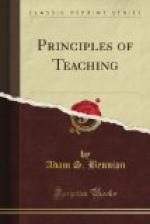* * * * *
QUESTIONS AND SUGGESTIONS—CHAPTER XVII
1. What is an aim?
2. Why is it particularly essential to good religious teaching?
3. What are the objections to “eleventh-hour” preparation?
4. To what extent is a teacher handicapped in deciding upon an aim for another teacher to follow?
5. Turn to the following references and determine what possible aims might be developed under each. Is any aim adequate for the whole reference? In each case which do you consider your best aim? Why? How much of the reference would you include in a single lesson?
John, Chapter I; Isaiah, Chapter II; III Nephi, Chapter X; Doctrine & Covenants, Section 87.
HELPFUL REFERENCES
Colgrove, The Teacher and the School; Betts, How to Teach Religion; Driggs, The Art of Teaching; Strayer and Norsworthy, How to Teach.
CHAPTER XVIII
APPLICATION
OUTLINE—CHAPTER XVIII
The question of application.—The matter a complex one.—Various conceptions of the term as it affects the intellect, the emotions, or the will.—Application may be immediate or delayed.—How to make the application.—Illustrations.—Making the application and moralizing.—Utah moral codes as objectives behind our teaching.
Application is one of the most important subjects in the whole range of religious education. It is also one concerning which there are greater varieties of opinions than concerning almost any other subject.
What is application?
How is it made?
Is it inherent in the lesson, or is it added as a sort of supplement to the lesson?
When is it best made?
Does it always involve action?
These questions are only typical of the uncertainty that exists relative to this term.
Application really goes to the very heart of all teaching. Colloquially expressed, it raises the question in teaching, “What’s the use?” Why should certain subject matter be presented to a class? How are class members better for having considered particular facts? In short, application involves the question, “What is the carry-over value of the lesson?”
It is impossible to dispose adequately of the matter of application in a single statement. It fairly epitomizes the whole process of teaching and therefore is so comprehensive that it calls for analysis. The ultimate purpose behind teaching, of course, as behind all life, is salvation. But salvation is not had in a day. It is not the result of a single act, nor does it grow out of particular thoughts and aspirations. Salvation is achieved as a sum total of all that we think, say, do, and are. Any lesson, therefore, that makes pupils better in thought, word, deed, or being, has had to that extent its application.




